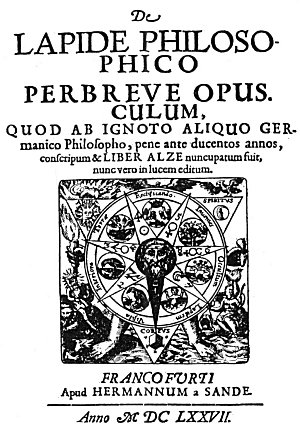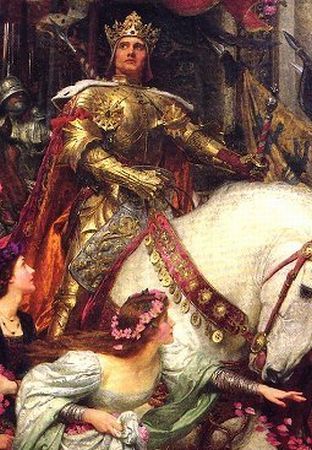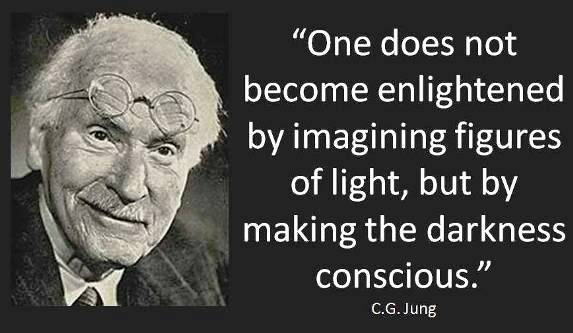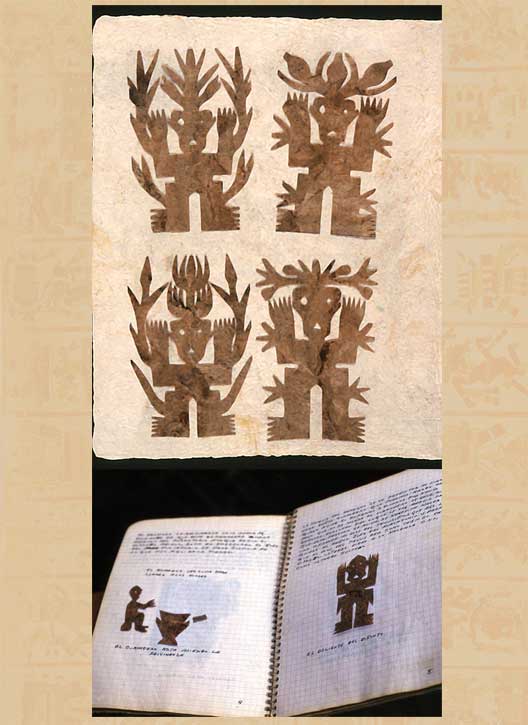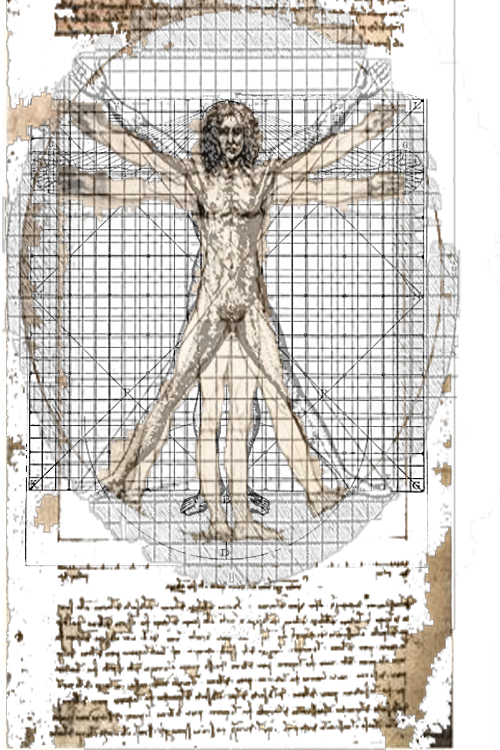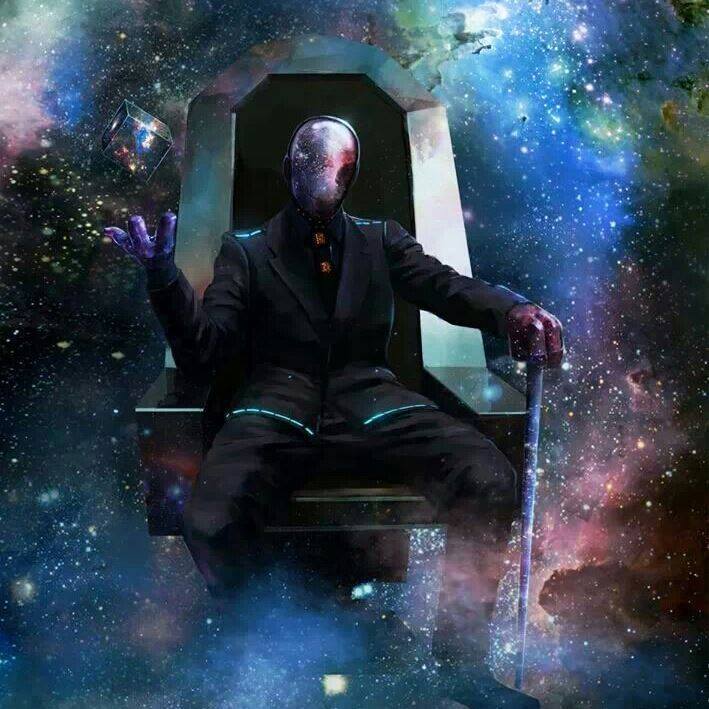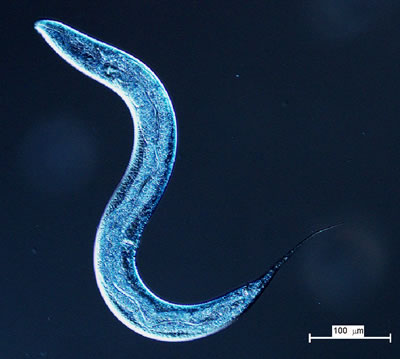p. A6
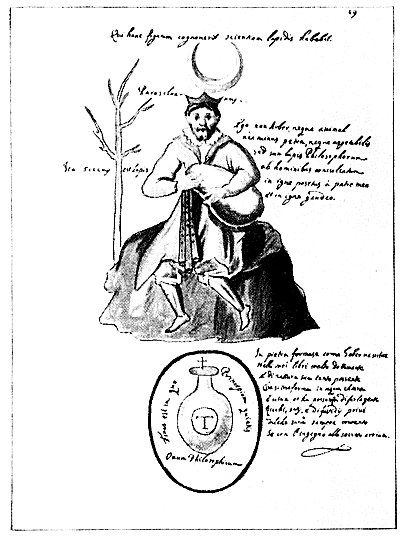 Leaf 19. At the top it reads: “He that comes to know this figure will have knowledge of the Stone.” The seated man probably represents Paracelsus. To his right are the words: “I am neither tree nor animal, nor stone nor vegetable, but the Philosopher’s Stone, trampled on by men, cast into the fire by my father, and in fire I rejoice.” The four words to the left say “In dryness is the Stone.” Below the man is the Philosophic Egg containing the words: “It is the end in which the beginning rests.” The capital T stands for “Tincture.” The text to the right states: “In Stone it is formed, as Gerber writes in his book very learnedly, and possessing so much of its nature that it changes into clear, living water; and it has the power to make folks rich, satisfied, and free from all cares, so they will be always happy if they attain by their wit to the secret.”
Leaf 19. At the top it reads: “He that comes to know this figure will have knowledge of the Stone.” The seated man probably represents Paracelsus. To his right are the words: “I am neither tree nor animal, nor stone nor vegetable, but the Philosopher’s Stone, trampled on by men, cast into the fire by my father, and in fire I rejoice.” The four words to the left say “In dryness is the Stone.” Below the man is the Philosophic Egg containing the words: “It is the end in which the beginning rests.” The capital T stands for “Tincture.” The text to the right states: “In Stone it is formed, as Gerber writes in his book very learnedly, and possessing so much of its nature that it changes into clear, living water; and it has the power to make folks rich, satisfied, and free from all cares, so they will be always happy if they attain by their wit to the secret.”
 Leaf 20. At the top is written: “Rains are made by six stars.” Under the inverted man it reads: “Receive new spirit. Arise, for you are asleep.” The two sentences about the large figure read: “Remember Mercury, for ashes thou art and unto ashes thou shalt return. I thirst and am dead.” Above the seven globes at the left is the admonition: “If he thirst, give him a drink and he shall live.” Over the small man is written: “Hermes, the father of philosophers.” The curved line of writing to which Hermes points says: “The measure of the drink.” Under the central pedestal appears: “The light of my eyes is a lantern to my feet.” Below is added: “If the beginning is unknown, the rest is unknown.” Above the figure rising from the flames on the right is the statement: “He was resurrected after new Moon,” and under the eagle: “Thou shalt not fly further with me.”
Leaf 20. At the top is written: “Rains are made by six stars.” Under the inverted man it reads: “Receive new spirit. Arise, for you are asleep.” The two sentences about the large figure read: “Remember Mercury, for ashes thou art and unto ashes thou shalt return. I thirst and am dead.” Above the seven globes at the left is the admonition: “If he thirst, give him a drink and he shall live.” Over the small man is written: “Hermes, the father of philosophers.” The curved line of writing to which Hermes points says: “The measure of the drink.” Under the central pedestal appears: “The light of my eyes is a lantern to my feet.” Below is added: “If the beginning is unknown, the rest is unknown.” Above the figure rising from the flames on the right is the statement: “He was resurrected after new Moon,” and under the eagle: “Thou shalt not fly further with me.”
 Leaf 21. The upper line reads: “Two things and double, but finally one is dissolved into the first and they make sperm.” The four capitals. I A A T, are the initial letters of the names of the elements: Ignis, Aer, Aqua, and Terra. The writing under them reads: “Our fire is water; if you can give fire to fire, fire and Mercury will suffice.” Along the arm appear the words: “The Art of the Stone is,” and on the ribbon: “Swift, brief, bright, and rare.” The two lines under the ribbon read: “Every hand is a key, because it was called the herb celandine”; under the Sun: “I am the gift of God ” The verse reads: “So that you remain contented in all matters, I must listen attentively. My body [is] naked, clean, and shining, and I run like oil ready to drop, resplendent like bright gold, and then succumb to the plague in its bright and cheerful little chamber [retort].”
Leaf 21. The upper line reads: “Two things and double, but finally one is dissolved into the first and they make sperm.” The four capitals. I A A T, are the initial letters of the names of the elements: Ignis, Aer, Aqua, and Terra. The writing under them reads: “Our fire is water; if you can give fire to fire, fire and Mercury will suffice.” Along the arm appear the words: “The Art of the Stone is,” and on the ribbon: “Swift, brief, bright, and rare.” The two lines under the ribbon read: “Every hand is a key, because it was called the herb celandine”; under the Sun: “I am the gift of God ” The verse reads: “So that you remain contented in all matters, I must listen attentively. My body [is] naked, clean, and shining, and I run like oil ready to drop, resplendent like bright gold, and then succumb to the plague in its bright and cheerful little chamber [retort].”
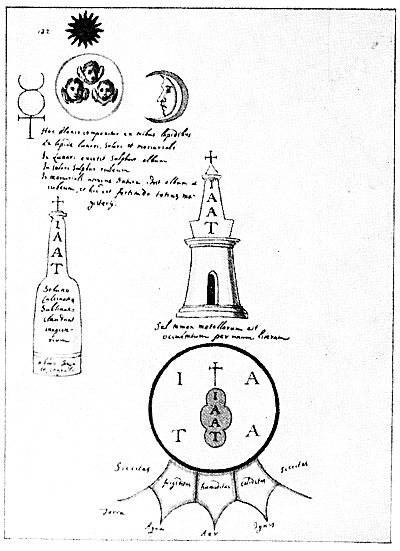 Leaf 22. The verse in the upper left is as follows: “This group is composed of three stones: lunar, solar, and mercurial. In the lunar is white sulphur; in the solar, red sulphur, in the mercurial, both; i.e. white and red, and this is the strength of all instruction.” In the bottle at the left are the words: “Dissolving, calcination, sublimation complete the instruction”; and at the base: “Wash, congeal, and coagulate. ” Under the central tower is written: “Metallic salts, however, are hidden by one letter”; around the bottom of the red circle: “Dryness, coldness, humidity, heat, and dryness.” On the points below are the names of the four elements. The initial, I A A T appear four times with the same meaning as that already given. The three powers of the Philosopher’s Stone are symbolized by the heads of the cherubs in the circle in the upper left corner.
Leaf 22. The verse in the upper left is as follows: “This group is composed of three stones: lunar, solar, and mercurial. In the lunar is white sulphur; in the solar, red sulphur, in the mercurial, both; i.e. white and red, and this is the strength of all instruction.” In the bottle at the left are the words: “Dissolving, calcination, sublimation complete the instruction”; and at the base: “Wash, congeal, and coagulate. ” Under the central tower is written: “Metallic salts, however, are hidden by one letter”; around the bottom of the red circle: “Dryness, coldness, humidity, heat, and dryness.” On the points below are the names of the four elements. The initial, I A A T appear four times with the same meaning as that already given. The three powers of the Philosopher’s Stone are symbolized by the heads of the cherubs in the circle in the upper left corner.
p. A7
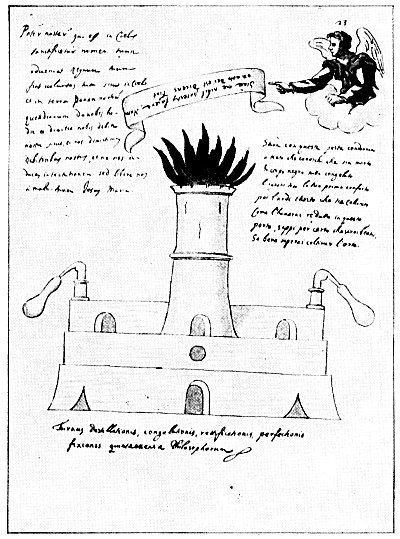 Leaf 23. The writing at the upper left is, in substance, the Lord’s Prayer, with the addition of the words Jesus and Maryat the end. The inverted words in the banner read: “Ye can do nothing without me, for God has so promised, saying ‘So be it.'” The text under the angel reads: “By this plague he will be damned who knows he is dead, all cold in a black body. And let this be thy first comfort: then he will burn unto calcination. When I have reduced him within this door, know for certain that I shall be blessed if I shall know how to cultivate the garden.” The main part of the leaf is devoted to an elaborate symbolic drawing of alchemical equipment, under which are the words: “The furnace of distillation, congealing, rectification, perfection, fixation: quintessence of the Philosophers.” By “quintessence” should be understood the “fifth essence” of the most wise.
Leaf 23. The writing at the upper left is, in substance, the Lord’s Prayer, with the addition of the words Jesus and Maryat the end. The inverted words in the banner read: “Ye can do nothing without me, for God has so promised, saying ‘So be it.'” The text under the angel reads: “By this plague he will be damned who knows he is dead, all cold in a black body. And let this be thy first comfort: then he will burn unto calcination. When I have reduced him within this door, know for certain that I shall be blessed if I shall know how to cultivate the garden.” The main part of the leaf is devoted to an elaborate symbolic drawing of alchemical equipment, under which are the words: “The furnace of distillation, congealing, rectification, perfection, fixation: quintessence of the Philosophers.” By “quintessence” should be understood the “fifth essence” of the most wise.
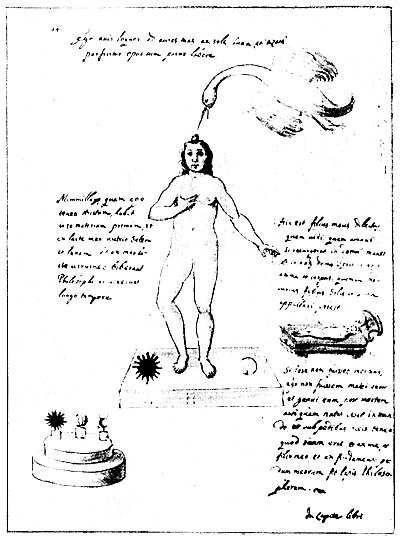 Leaf 24. The words at the top read: “I, the bird [the adept], speak into thine ears from the Sun, Moon and Azoth. The work is perfected with little labor.” The panel to the left describes the nature of primordial matter and the drink of the Philosophers. The text to the right reads: “This is my beloved Son whom I saw and loved. If he be resurrected, He will remain at home, and in that house the spirit will be the soul and the body; for Mercury may be called the son of the Sun and the Moon.” Under the child’s figure is added: “If he were not dead, I should not have been his mother. I bore him after death before he was born in the world; under my feet I have what was his, and out of me and my Son and the foundation of my feet the Philosopher’s Stone is made.” At the lower left the three constituents of the Stone are shown elevated upon a pedestal to signify their dignity.
Leaf 24. The words at the top read: “I, the bird [the adept], speak into thine ears from the Sun, Moon and Azoth. The work is perfected with little labor.” The panel to the left describes the nature of primordial matter and the drink of the Philosophers. The text to the right reads: “This is my beloved Son whom I saw and loved. If he be resurrected, He will remain at home, and in that house the spirit will be the soul and the body; for Mercury may be called the son of the Sun and the Moon.” Under the child’s figure is added: “If he were not dead, I should not have been his mother. I bore him after death before he was born in the world; under my feet I have what was his, and out of me and my Son and the foundation of my feet the Philosopher’s Stone is made.” At the lower left the three constituents of the Stone are shown elevated upon a pedestal to signify their dignity.
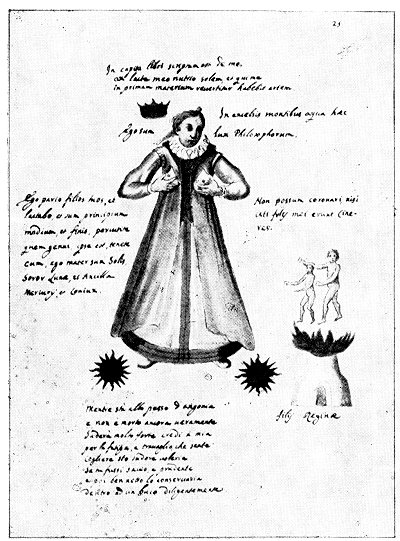 Leaf 25. Above the figure of the Queen are three lines stating, in substance, that in the beginning of the book it was written of her that from her maternal breasts she nourished the Sun, and that he who was capable of converting her into Primal matter possessed rare skill. Opposite the Queen’s head are the words: “In the highest mountains this water” and “I am the light of the Philosophers.” To the left of the Queen is an admonition to strike the sons whom she bears. She calls herself “The mother of the Sun, the sister of the Moon, and the servant and spouse of Mercury.” On the right she is made to exclaim: “I cannot be crowned unless these sons of mine become ashes. ” The sons are shown directly below. The verse under the Queen continues the alchemical processes, describing the method in which the exudations from the substance should be preserved.
Leaf 25. Above the figure of the Queen are three lines stating, in substance, that in the beginning of the book it was written of her that from her maternal breasts she nourished the Sun, and that he who was capable of converting her into Primal matter possessed rare skill. Opposite the Queen’s head are the words: “In the highest mountains this water” and “I am the light of the Philosophers.” To the left of the Queen is an admonition to strike the sons whom she bears. She calls herself “The mother of the Sun, the sister of the Moon, and the servant and spouse of Mercury.” On the right she is made to exclaim: “I cannot be crowned unless these sons of mine become ashes. ” The sons are shown directly below. The verse under the Queen continues the alchemical processes, describing the method in which the exudations from the substance should be preserved.
 Leaf 26. This page, which concludes that part of the Hermetic manuscript bearing the symbols of the Secret Work, contains a number of emblems not directly correlated. At the top is the head of the King–the most common of alchemical figures. To the right of the King is an alchemical vessel designated the Hermetic Seal. Below is the head of a ferocious bird, here designated a griffon. To the left of the King is a headless figure elevating a Sun, or spiritual face. This figure is the world, which must be headless, since its spiritual and rational part is not material and consequently, is invisible. Below is a circle unaccompanied by descriptive matter. Directly under the King’s head is a vase of flowers, in which rises the golden plant of the Philosophers. At the bottom of the page is additional alchemical equipment, this also being termed a Hermetic Seal.
Leaf 26. This page, which concludes that part of the Hermetic manuscript bearing the symbols of the Secret Work, contains a number of emblems not directly correlated. At the top is the head of the King–the most common of alchemical figures. To the right of the King is an alchemical vessel designated the Hermetic Seal. Below is the head of a ferocious bird, here designated a griffon. To the left of the King is a headless figure elevating a Sun, or spiritual face. This figure is the world, which must be headless, since its spiritual and rational part is not material and consequently, is invisible. Below is a circle unaccompanied by descriptive matter. Directly under the King’s head is a vase of flowers, in which rises the golden plant of the Philosophers. At the bottom of the page is additional alchemical equipment, this also being termed a Hermetic Seal.

Moe is the founder of GnosticWarrior.com. He is a father, husband, author, martial arts black belt, and an expert in Gnosticism, the occult, and esotericism.

![How Claudius, the second of the Romans who came into Britain, brought the islands Orcades into subjection to the Roman empire; and Vespasian, sent by hint, reduced the Isle of Wight under the dominion of the Romans [44 AD] | Book 1 | Chapter 3 How Claudius, the second of the Romans who came into Britain, brought the islands Orcades into subjection to the Roman empire; and Vespasian, sent by hint, reduced the Isle of Wight under the dominion of the Romans [44 AD] | Book 1 | Chapter 3](https://www.gnosticwarrior.com/wp-content/plugins/contextual-related-posts/default.png)
